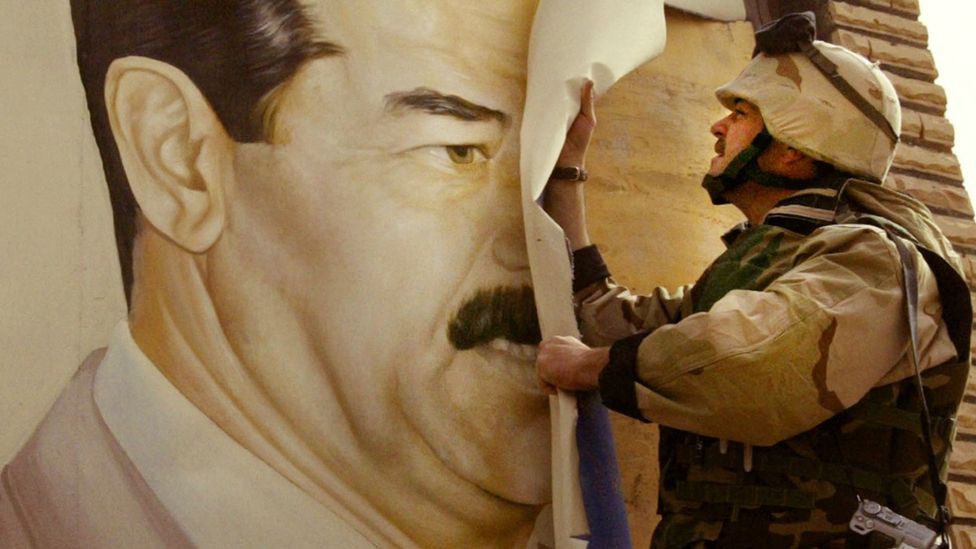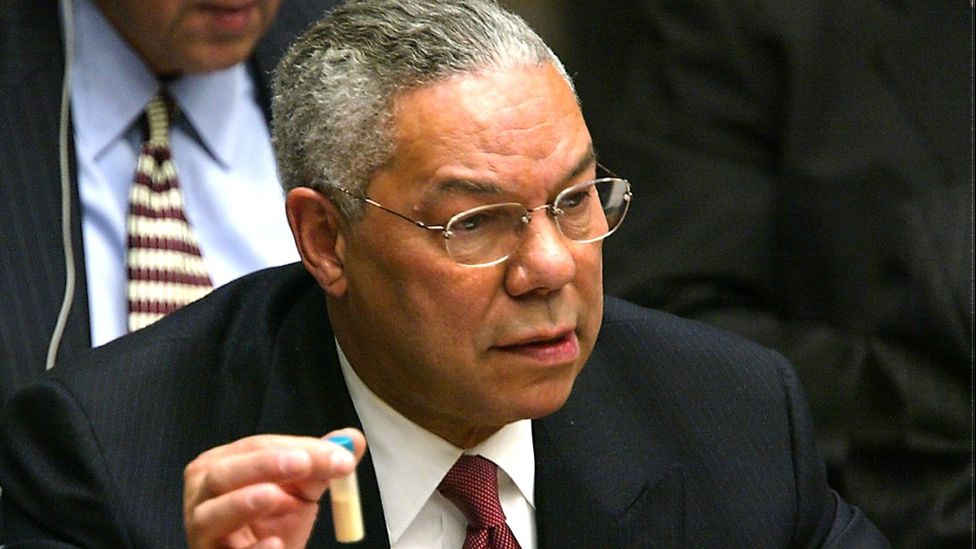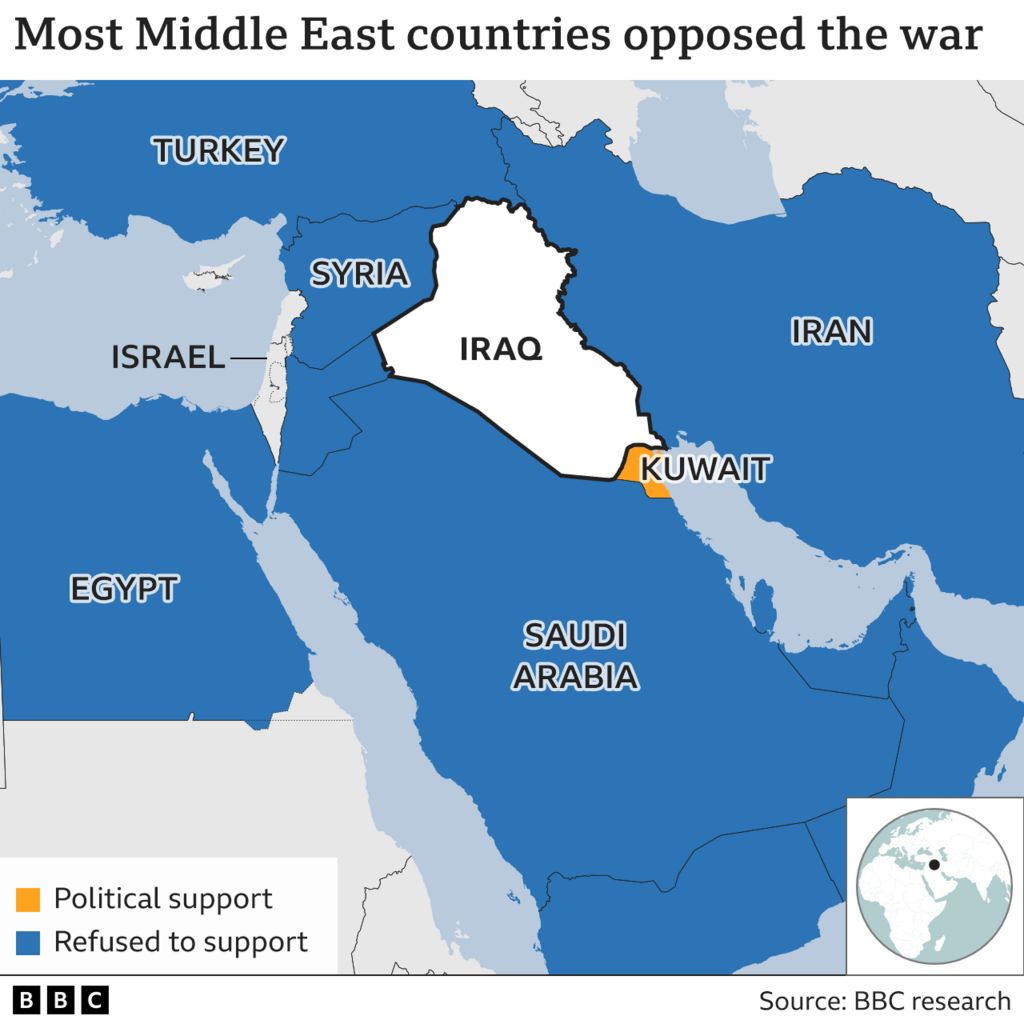
The 2003 invasion of Iraq toppled President Saddam Hussein
On 20 March 2003, US and allied forces invaded Iraq and toppled Saddam Hussein's regime.
The US said Iraq had weapons of mass destruction and was a threat to international peace, but most countries refused to support military action against it.
Why did the US want to invade Iraq?
In the Gulf War of 1990-1991, the US had led a multinational coalition which forced invading Iraqi forces out of Kuwait.
Afterwards, the UN Security Council passed Resolution 687 ordering Iraq to destroy all its weapons of mass destruction (WMDs) - a term used to describe nuclear, biological and chemical weapons, and long-range ballistic missiles.
In 1998, Iraq suspended cooperation with UN weapons inspectors, and the US and UK responded with air strikes.
After al-Qaeda's 11 September 2001 attacks on the World Trade Center in New York and the Pentagon in Washington, President George W Bush's administration started making plans to invade Iraq.
President Bush claimed Saddam was continuing to stockpile and manufacture WMDs and that Iraq was part of an international "axis of evil", along with Iran and North Korea.
In October 2002, the US Congress authorised the use of military force against Iraq.
"Many people in Washington believed that there was significant evidence that Iraq had weapons of mass destruction, and that it posed a genuine threat," says Dr Leslie Vinjamuri, director of the US and Americas Programme at Chatham House, a foreign affairs think tank in London.
In February 2003, then-US Secretary of State Colin Powell asked the UN Security Council to give the go-ahead for military action against Iraq, saying it was violating previous resolutions with its alleged WMD programme.
However, he did not persuade the Council. Most of its members wanted weapons inspectors from the UN and International Energy Authority - who had gone to Iraq in 2002 - to carry out more work there to find evidence of WMDs.
The US said it would not wait for the inspectors to report, and assembled a "coalition of the willing" against Iraq.
Who supported the war?
Of the 30 countries in the coalition, the UK, Australia and Poland participated in the invasion.
The UK sent 45,000 troops, Australia sent 2,000 troops and Poland sent 194 special forces members.
Kuwait allowed the invasion to be launched from its territory.
Spain and Italy gave diplomatic support to the US-led coalition, along with several east European nations in the "Vilnius Group", who said they believed that Iraq had a WMD programme and was violating UN resolutions.
What allegations did the US and UK make against Iraq?
US Secretary of State Colin Powell told the UN in 2003 that Iraq had "mobile labs" for producing biological weapons.
However, he acknowledged in 2004 that the evidence for this "appears not to be... that solid".

On 20 March 2003, US and allied forces invaded Iraq and toppled Saddam Hussein's regime.
The US said Iraq had weapons of mass destruction and was a threat to international peace, but most countries refused to support military action against it.
Why did the US want to invade Iraq?
In the Gulf War of 1990-1991, the US had led a multinational coalition which forced invading Iraqi forces out of Kuwait.
Afterwards, the UN Security Council passed Resolution 687 ordering Iraq to destroy all its weapons of mass destruction (WMDs) - a term used to describe nuclear, biological and chemical weapons, and long-range ballistic missiles.
In 1998, Iraq suspended cooperation with UN weapons inspectors, and the US and UK responded with air strikes.
After al-Qaeda's 11 September 2001 attacks on the World Trade Center in New York and the Pentagon in Washington, President George W Bush's administration started making plans to invade Iraq.
President Bush claimed Saddam was continuing to stockpile and manufacture WMDs and that Iraq was part of an international "axis of evil", along with Iran and North Korea.
In October 2002, the US Congress authorised the use of military force against Iraq.
"Many people in Washington believed that there was significant evidence that Iraq had weapons of mass destruction, and that it posed a genuine threat," says Dr Leslie Vinjamuri, director of the US and Americas Programme at Chatham House, a foreign affairs think tank in London.
In February 2003, then-US Secretary of State Colin Powell asked the UN Security Council to give the go-ahead for military action against Iraq, saying it was violating previous resolutions with its alleged WMD programme.
However, he did not persuade the Council. Most of its members wanted weapons inspectors from the UN and International Energy Authority - who had gone to Iraq in 2002 - to carry out more work there to find evidence of WMDs.
The US said it would not wait for the inspectors to report, and assembled a "coalition of the willing" against Iraq.
Who supported the war?
Of the 30 countries in the coalition, the UK, Australia and Poland participated in the invasion.
The UK sent 45,000 troops, Australia sent 2,000 troops and Poland sent 194 special forces members.
Kuwait allowed the invasion to be launched from its territory.
Spain and Italy gave diplomatic support to the US-led coalition, along with several east European nations in the "Vilnius Group", who said they believed that Iraq had a WMD programme and was violating UN resolutions.
What allegations did the US and UK make against Iraq?
US Secretary of State Colin Powell told the UN in 2003 that Iraq had "mobile labs" for producing biological weapons.
However, he acknowledged in 2004 that the evidence for this "appears not to be... that solid".

US Secretary of State Colin Powell told the UN that Iraq was producing weapons of mass destructions
The UK government made public an intelligence dossier claiming that Iraqi missiles could be readied within 45 minutes to hit UK targets in the eastern Mediterranean.
The UK's then-Prime Minister, Tony Blair, said it was "beyond doubt" that Saddam Hussein was continuing to produce WMD.
The two countries relied heavily on the claims of two Iraqi defectors - a chemical engineer called Rafid Ahmed Alwan al-Janabi and an intelligence officer called Maj Muhammad Harith - who said they had first-hand knowledge of Iraq's WMD programme.
Both men later said they had fabricated their evidence because they wanted the allies to invade and oust Saddam.
Who refused to support the war?
Two neighbours of the US, Canada and Mexico, refused to support it.
Germany and France, two key US allies in Europe, also refused support.

French foreign minister Dominique de Villepin said military intervention would be "the worst possible solution".
Turkey - a fellow Nato member and neighbour of Iraq - refused to let the US and allies use its airbases.
Middle Eastern countries which had supported the US against Iraq in the 1990-91 Gulf War, such as Saudi Arabia, did not support its invasion in 2003.

"The Gulf Arab states thought the plan was crazy," says Professor Gilbert Achcar, an expert in Middle Eastern politics at University of London SOAS.
"They were worried about Iran getting control of Iraq after the fall of Saddam's regime."
What happened in the war?
At dawn on 20 March 2003, Operation Iraqi Freedom began with 295,000 US and allied troops invading Iraq across its border with Kuwait.
70,000 members of the Kurdish Peshmerga militia fought Iraqi forces in the north of the country.
By May, Iraq's army had been defeated and its regime overthrown. Saddam Hussein was later captured, tried and executed.
However, no weapons of mass destruction were found in Iraq.
In 2004, the country was engulfed by a sectarian insurgency. In later years, a civil war broke out between Iraq's Sunni and Shi'a Muslim factions.
US troops withdrew from Iraq in 2011.
It is estimated that 461,000 people died in Iraq from war-related causes between 2003 and 2011 and that the war cost the US $3 trillion.
"America lost a lot of credibility from this war," says Dr Karin von Hippel, director-general of the Royal United Services Institute think tank.
The UK government made public an intelligence dossier claiming that Iraqi missiles could be readied within 45 minutes to hit UK targets in the eastern Mediterranean.
The UK's then-Prime Minister, Tony Blair, said it was "beyond doubt" that Saddam Hussein was continuing to produce WMD.
The two countries relied heavily on the claims of two Iraqi defectors - a chemical engineer called Rafid Ahmed Alwan al-Janabi and an intelligence officer called Maj Muhammad Harith - who said they had first-hand knowledge of Iraq's WMD programme.
Both men later said they had fabricated their evidence because they wanted the allies to invade and oust Saddam.
Who refused to support the war?
Two neighbours of the US, Canada and Mexico, refused to support it.
Germany and France, two key US allies in Europe, also refused support.

French foreign minister Dominique de Villepin said military intervention would be "the worst possible solution".
Turkey - a fellow Nato member and neighbour of Iraq - refused to let the US and allies use its airbases.
Middle Eastern countries which had supported the US against Iraq in the 1990-91 Gulf War, such as Saudi Arabia, did not support its invasion in 2003.

"The Gulf Arab states thought the plan was crazy," says Professor Gilbert Achcar, an expert in Middle Eastern politics at University of London SOAS.
"They were worried about Iran getting control of Iraq after the fall of Saddam's regime."
What happened in the war?
At dawn on 20 March 2003, Operation Iraqi Freedom began with 295,000 US and allied troops invading Iraq across its border with Kuwait.
70,000 members of the Kurdish Peshmerga militia fought Iraqi forces in the north of the country.
By May, Iraq's army had been defeated and its regime overthrown. Saddam Hussein was later captured, tried and executed.
However, no weapons of mass destruction were found in Iraq.
In 2004, the country was engulfed by a sectarian insurgency. In later years, a civil war broke out between Iraq's Sunni and Shi'a Muslim factions.
US troops withdrew from Iraq in 2011.
It is estimated that 461,000 people died in Iraq from war-related causes between 2003 and 2011 and that the war cost the US $3 trillion.
"America lost a lot of credibility from this war," says Dr Karin von Hippel, director-general of the Royal United Services Institute think tank.
"You still hear people saying, twenty years later: why do we want to believe American intelligence?"


Shock And War: Iraq 20 Years On
The BBC's security correspondent Gordon Corera seeks to find new answers to why the Iraq war happened, what it meant, and its legacy today.
Download all 10 episodes on BBC Sounds
No comments:
Post a Comment